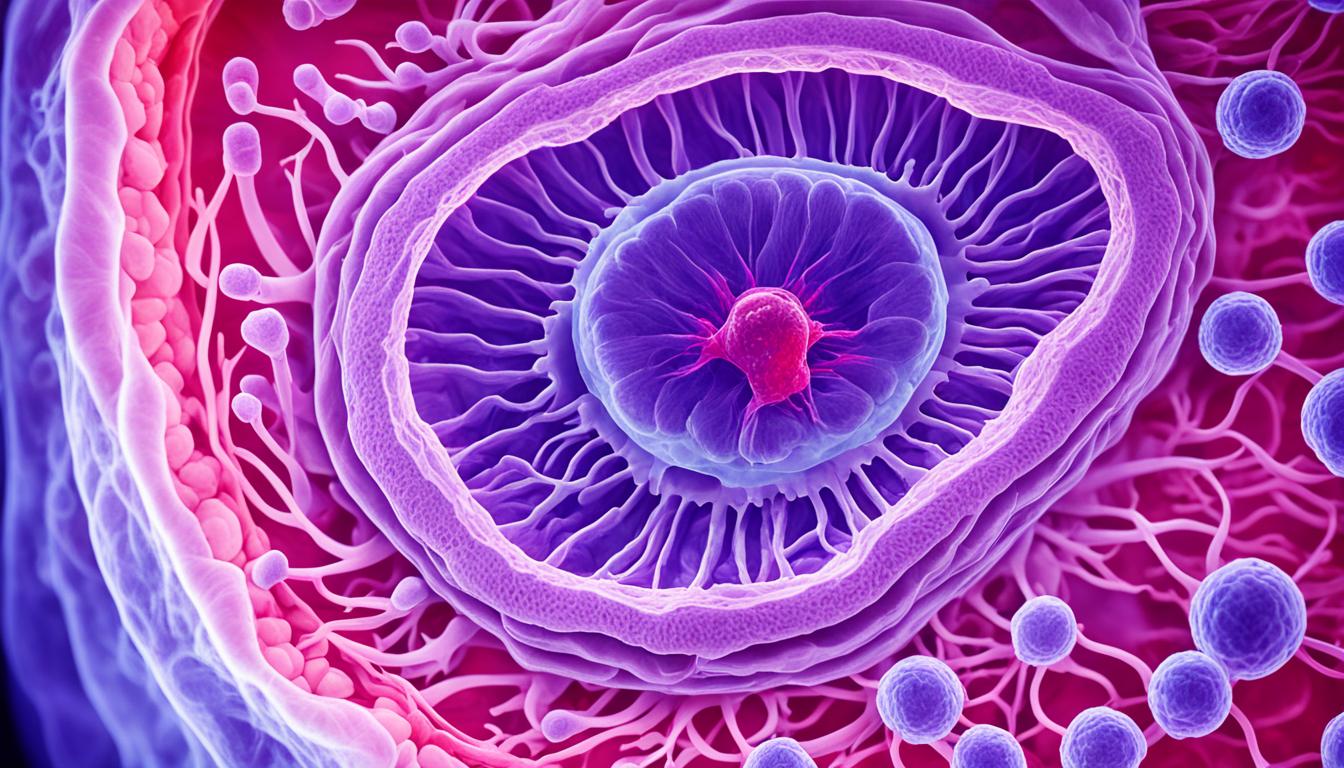A hiatal hernia is when the stomach’s upper part sticks out through the diaphragm. It can cause acid reflux, heartburn, and pain when swallowing. Risk factors for this condition include being overweight, being pregnant, and having a family history of hernias.
Doctors diagnose hiatal hernias with tests like an upper GI swallow or endoscopy. Treatment can be simple, like just watching. But sometimes, surgery is needed. Excitingly, stem cell therapy is being explored as a new way to treat hiatal hernias.
Key Takeaways:
- Hernia hiatal disease occurs when the stomach protrudes through the diaphragm.
- Symptoms of hiatal hernia include acid reflux, heartburn, regurgitation, chest pain, and difficulty swallowing.
- Risk factors for hiatal hernia include obesity, pregnancy, constipation, COPD, trauma, previous surgeries, and genetics.
- Diagnosis of hiatal hernia can be done through tests like upper GI swallow study, upper endoscopy, and esophageal manometry.
- Treatment options vary based on the size and symptoms of the hernia, ranging from observation to surgery.
- Stem cell therapy shows potential as a treatment option for hiatal hernia.
Types of hiatal hernia and associated complications
A hiatal hernia has several types, each with unique features and issues that may result.
1. Sliding Hernia (Type 1)
Sliding hernias are the most frequent kind. The top part of the stomach moves up.
This happens because the area where the esophagus joins the stomach slips above the diaphragm’s hole.
2. Paraesophageal Hernia (Type 2)
Paraesophageal hernias are less common. The top part of the stomach shifts next to the esophagus.
Here, the joining point of the esophagus and stomach doesn’t move. But the stomach does.
3. Mixed Hernia (Type 3)
A mixed hernia has elements of both sliding and paraesophageal types. This mix lets both the stomach and esophagus move.
These hernias come with their own set of symptoms and problems.
4. Giant Hernia (Type 4)
Giant hernias are very serious. Here, a large portion of the stomach or other organs push through the diaphragm.
This can lead to significant symptoms and issues, needing quick medical care.
The problems with hiatal hernias change depending on type and seriousness. Some complications include:
- Ulcerative esophagitis: Inflammation of the esophagus lining, which can lead to ulcers
- Bleeding: Hiatal hernias, especially with ulcers, can lead to internal bleeding
- Gastric volvulus: Stomach twisting that can cause cut off blood supply and organ damage
- Reflux disease: Stomach acid moving up into the esophagus
- Obstruction: The herniated stomach part can get stuck, causing swallowing and digestion issues
It’s key to know about different hernia types and their problems. This helps in better diagnosis and treatment. Seek advice from a doctor for the best steps to deal with hiatal hernias.
Managing hiatal hernia and potential stem cell therapy
How we handle hiatal hernia depends on its size and if it causes symptoms. For small hernias with no symptoms, we might just watch them. Keeping an eye on it can make sure it doesn’t get worse or hurt you. Lifestyle changes for hiatal hernia are key too. Losing weight, not lifting too heavy, and avoiding certain foods can ease symptoms and stop problems.
But, when hernias are big and cause issues like GERD, surgery might be needed. The main goal of hiatal hernia surgery, like fundoplication, is to fix the hernia. It also strengthens a muscle to keep stomach acid from coming up. Surgery gives a lot of relief and can make life much better for those with hiatal hernias.
Nowadays, there’s talk about using stem cell therapy for hiatal hernia. Stem cells can help damaged areas in the body heal. Doctors hope that by using stem cells, they can make the hernia area better and cut down symptoms. This new area of medicine looks promising. It might lead to new, non-surgical ways to treat hiatal hernias. But we still need more study to see how well it really works.
So, handling a hiatal hernia is all about what works best for each person. Small changes to what you do and eat can help a lot. But if the hernia is big and causing symptoms, surgery might be the best step. And now, there’s also stem cell therapy showing up. It offers a different way to repair the body. As we learn more, the ways to deal with hiatal hernias will keep getting better. This means a brighter future for those living with this condition.
FAQ
Q: What is a hiatal hernia?
A: A hiatal hernia happens when the stomach pushes through the diaphragm’s opening.
Q: What are the symptoms of hiatal hernia?
A: People with hiatal hernia might feel acid reflux, heartburn, or have trouble swallowing. They may also get chest pain.
Q: What are the risk factors for hiatal hernia?
A: Being obese, pregnant, or having a chronic illness like COPD may raise your risk. So can constipation, trauma, or a history of surgeries, including genetic factors.
Q: How is hiatal hernia diagnosed?
A: Doctors use tests like the upper GI study, endoscopy, or manometry to diagnose hiatal hernia.
Q: What are the different types of hiatal hernia?
A: Hiatal hernias come in types: sliding (type 1), paraesophageal (type 2), mixed (type 3), and giant (type 4).
Q: What are the complications of hiatal hernia?
A: Serious issues like ulcerative esophagitis or gastric volvulus can arise, leading to bleeding or obstruction.
Q: How is hiatal hernia managed?
A: Treatment varies. Doctors might watch small hernias not causing symptoms. Surgery could help if the hernia is large and triggers GERD.
Q: Can stem cell therapy be used to treat hiatal hernia?
A: Stem cell therapy is seen as a possible way to treat hiatal hernia. It aims to regrow tissue and heal, easing symptoms. We still need more studies to confirm its benefits and safety.

